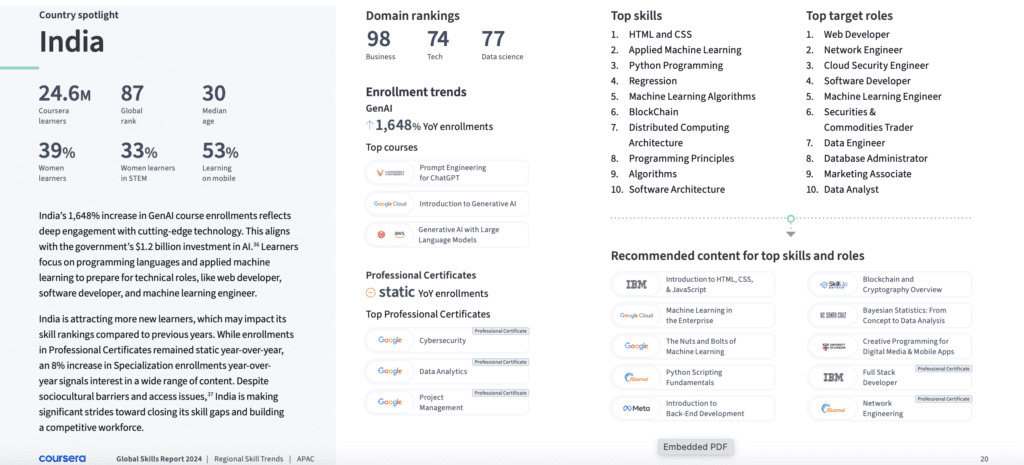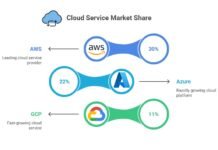India’s educational and professional landscape has been rapidly evolving, especially in the realm of digital skills and technologies. The Global Skill Report 2024 sheds light on the burgeoning trends, top skills, and courses shaping the future workforce in India. This article delves into the key insights from the report, highlighting the nation’s progress and potential.
A Surge in Learners and Technological Engagement
India boasts a significant number of Coursera learners, standing at 24.6 million. The demographic is young, with a median age of 30, and includes a substantial proportion of women learners (39%), with 33% of them engaged in STEM fields. Notably, 53% of learners are accessing content via mobile devices, reflecting the growing mobile internet penetration in the country.
The most striking figure is the 1,648% year-over-year increase in GenAI course enrollments. This surge is indicative of India’s deep engagement with cutting-edge technology, aligned with the government’s substantial $1.2 billion investment in artificial intelligence. Learners are particularly focused on programming languages and applied machine learning, preparing for technical roles such as web developer, software developer, and machine learning engineer.
Domain Rankings and Enrollment Trends
India’s global rankings in various domains are as follows:
• Business: 98
• Technology: 74
• Data Science: 77
These rankings may evolve as India continues to attract new learners and diversify its educational focus. While enrollments in professional certificates have remained static year-over-year, there has been an 8% increase in specialization enrollments, indicating a broadening interest in varied content areas.
Top Skills and Target Roles
The report identifies the top skills and target roles that are in demand in India:
Top Skills:
1. HTML and CSS
2. Applied Machine Learning
3. Python Programming
4. Regression
5. Machine Learning Algorithms
6. Blockchain
7. Distributed Computing Architecture
8. Programming Principles
9. Algorithms
10. Software Architecture
Top Target Roles:
1. Web Developer
2. Network Engineer
3. Cloud Security Engineer
4. Software Developer
5. Machine Learning Engineer
6. Securities & Commodities Trader
7. Data Engineer
8. Database Administrator
9. Marketing Associate
10. Data Analyst
These skills and roles highlight the increasing need for expertise in both foundational and advanced technological areas. The prominence of machine learning, programming, and security-related roles underscores the critical nature of these fields in the current job market.
Recommended Content for Top Skills and Roles
To equip learners with the necessary skills for these roles, the report recommends specific courses and professional certificates:
• HTML, CSS & JavaScript by IBM
• Machine Learning in the Enterprise by Google Cloud
• The Nuts and Bolts of Machine Learning by Google
• Python Scripting Fundamentals by Akamai
• Introduction to Back-End Development by Meta
Additional recommended courses include:
• Blockchain and Cryptography Overview by SkillUp
• Bayesian Statistics: From Concept to Data Analysis by UC Santa Cruz
• Creative Programming for Digital Media & Mobile Apps by University of London
• Full Stack Developer Professional Certificate by IBM
• Network Engineering Professional Certificate by Akamai
Conclusion
India is making remarkable strides in bridging its skill gaps and fostering a technologically adept workforce. The focus on AI, machine learning, and other advanced technologies positions India as a pivotal player in the global tech landscape. As learners continue to engage with diverse and specialized content, the future looks promising for India’s role in driving innovation and technological advancement.
By leveraging these insights and recommendations, learners and professionals in India can strategically align their educational pursuits with market demands, ensuring they are well-prepared for the evolving job landscape.











[…] in computational power, the explosion of data availability, and significant progress in machine learning (ML). Machine learning, a subset of AI that empowers systems to learn from data rather than relying […]